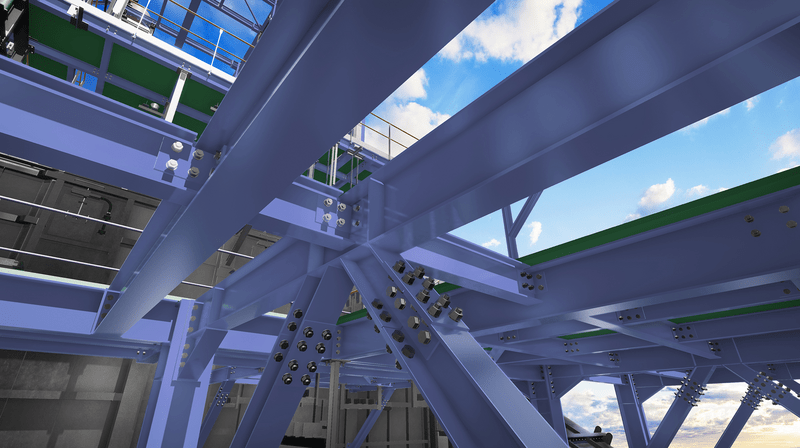Benefits of Digital Fabrication for Steel Industry Professionals

The technological advancements provided by digital fabrication have reshaped how steel industry professionals and company owners approach projects. In Southeast Asia, where the demand for steel structures is rapidly growing, digital fabrication is proving to be a game-changer, offering a host of benefits that those in the industry now count as essential.
Digital fabrication refers to the process of using digital technologies to design, model, and manufacture components in materials such as copper, thermoplastics, wood, and steel. This includes using computer-aided design (CAD) software, automated machinery, and cloud-based collaboration tools. The keen uptake of this new technology by the steel industry is due to its ability to significantly enhance accuracy, efficiency, and cost savings. It is not just a trend but a critical component of modern steel fabrication that helps companies stay competitive in an increasingly complex and demanding market.
This rise of digital fabrication in the steel industry brings three major benefits: enhanced precision and accuracy, increased efficiency and speed, and substantial cost savings and resource optimization. These advantages transform how steel industry professionals approach their work, from the initial design phase to the final construction and assembly.
Enhanced precision and accuracy
Digital fabrication offers unparalleled precision and accuracy, which are crucial in the steel industry, thanks to several attributes.
Computer-Aided Design, or CAD software, allows structural engineers to create detailed and accurate models of complex steel structures. This capability is essential in projects like high-rise buildings and bridges, where precise modelling of structural elements and connections is critical. Southeast Asia is witnessing rapid urbanisation, driving large-scale infrastructure construction. The use of CAD in digital fabrication is helping to reduce errors and inconsistencies, leading to safer and more reliable structures.
Detailing automation is a hallmark of digital fabrication. It uses intelligent parametric components that can be customised and reused, makes detailing steel faster and easier. This automation maximizes productivity by reducing the time, effort, and waste needed to create detailed designs, and it minimizes human error by ensuring that all components are consistent and accurate.
Repeatability is one of the key advantages of this technology, as it ensures that every component produced meets the required standards. This is particularly important in projects that require uniformity, such as mass-produced steel components for modular construction. The ability to replicate designs with high precision helps maintain quality across multiple production runs.
Increased efficiency and speed
Digital fabrication also streamlines the workflow of manufacturing and assembly processes, significantly reducing the time required to complete projects.
Streamlined workflows enable more efficient integration of the various stages of steel manufacturing and assembly. This integration reduces the time spent on each stage of the process, allowing projects to be completed more quickly. The construction industry is no stranger to pressure to meet tight deadlines, so this efficiency is a critical advantage.
The capability for rapid prototyping using digital fabrication technologies results in faster testing and shorter lead times. This is particularly beneficial in large-scale projects, where delays can be costly. For example, in the development of new industrial complexes in countries like Vietnam, rapid prototyping allows for quicker iterations and refinements, ensuring that the final product meets all specifications and sustainability standards.
Cloud-based collaboration facilitates essential real-time information sharing among project team members, regardless of their location. This capability enhances co-operation and reduces the risk of miscommunication, which can lead to costly delays. In multinational projects, such as the construction of cross-border infrastructure in Southeast Asia, cloud-based collaboration is essential for keeping all stakeholders aligned and informed.
Cost savings and resource optimization
One of the most compelling benefits of digital fabrication is its ability to deliver significant cost savings and optimize resource usage.
Steel detailing produces highly accurate shop drawings, fabrication documents, and bills of materials. These documents are essential for ensuring that all components are manufactured to the correct specifications, reducing the likelihood of costly rework.
Precise cutting and shaping of steel components minimizes waste and leads to more efficient use of materials. This optimization is particularly important in regions like Southeast Asia, where the cost of raw materials can be a significant factor in project budgets.
Digital fabrication reduces reliance on manual labor by automating many of the tasks traditionally performed by workers. This automation lowers labor costs and reduces the risk of human error, further enhancing profitability.
Enhancing precision and accuracy means minimized rework and errors. This eliminates one of the most significant sources of cost overruns in steel fabrication projects. By reducing errors, industry professionals directly contribute to the overall profitability of a project.
Maximize success with digital fabrication
Digital fabrication offers substantial benefits for steel industry professionals as they work to meet the rising demand for efficient, cost-effective construction solutions. The enhanced precision and accuracy provided by digital tools, combined with the increased efficiency and speed of automated processes, result in significant cost savings and resource optimization.
As the steel industry continues to evolve, embracing digital fabrication will be essential for staying competitive and meeting the growing demands of the construction sector. By leveraging these technologies, business owners can ensure that they deliver high-quality, reliable structures that meet the needs of today and tomorrow